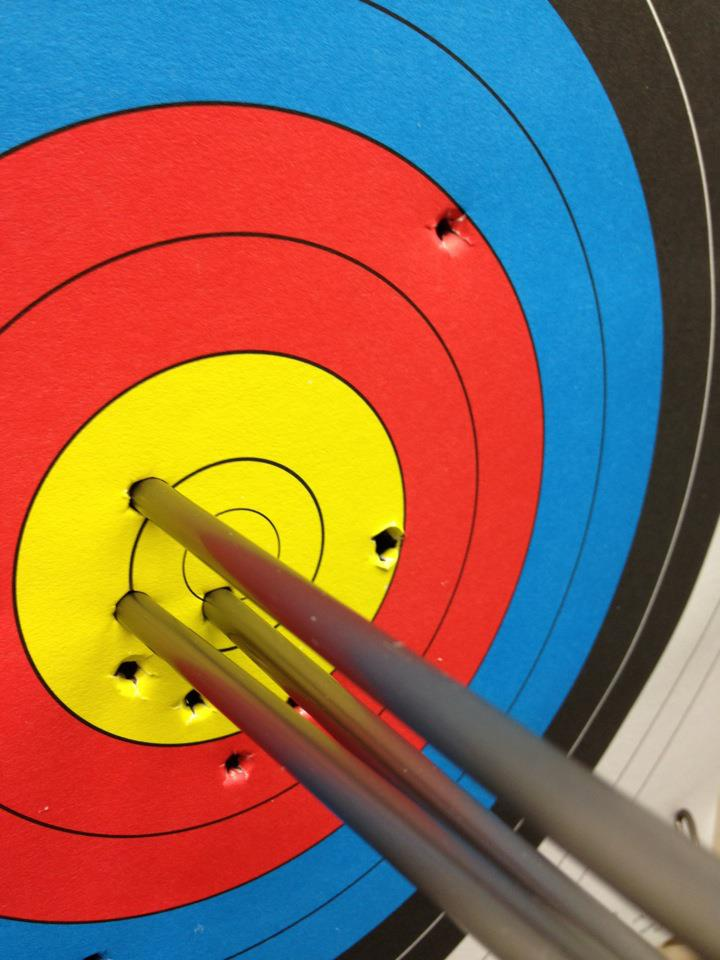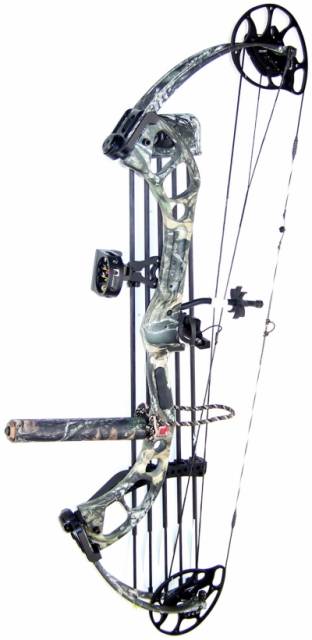Types Of Archery
- Bow hunting- Bow hunting is the act of hunting and harvesting any animal with a bow and arrow or crossbow. Most modern bow hunters prefer the use of Compound Bows (see section: types of bows) due to their cam assisted draw back and extreme stopping power. Bow hunters also use Traditional Bows that are closer to what native tribes and British Medieval archers would have used. A bow hunter sits in either a tree stand or a ground blind to camouflage his or her presence in an area know for animal traffic during rut season. Hunters also often use pheromone sprays and animal calls to attract their prey
- Olympic Archery- Olympic style archery has been a staple of the Olympic Summer Games since 1900 and has been contested in 14 different Olympiads.
- Olympic Format-
 A perfect End of Olympic Archery
A perfect End of Olympic Archery- Organization- There are four different medal events in the Olympics: Men's Team, Women's Team, Men's Individual and Women's Individual.
- Team Format- The traditional format for team competitions has teams of three archers face off in pairs determined by ranking. Competition was divided into rounds know as "ends." Each end in archery consists of each team shooting three arrows (one arrow per team member) at a target with 10 rings. There is a total of four ends for a grand total of twelve arrows fired by each team. Shooters on each team would shoot side by side with a shooter from the opposite team until 2008, when they changed the rules so that shooters from each team would alternate (shooter one-team one, then shooter one-team two, then shooter two team one and so on).
- Team Scoring- Each arrow is given a point total corresponding to the ring in which the arrow lands. On a standard archery target the smallest center ring is worth 10 points while the outer ring is worth 1. If you do not hit any rings then it is scored as an M and given a value of 0. At the completion of a 3 arrow end each team adds up their three arrows for a total end score. A perfect end in archery is a 30. The teams then take the end scores for all four ends and add them to a total match score. A perfect match score in the team format is a 120.
- Individual Format Prior to 2012- The individual format was identical to the team format prior to 2012, with archers shooting head to head in ends of three arrows. They would shoot a total of 6 ends equaling 18 arrows shot. The highest possible score in this format is a 180.
- Individual Format Post 2012- The 2012 games in London saw the archery individual format completely overhauled. They adopted a format used by the Archery World Cup. In this format shooters would alternate arrows and shoot three arrow ends. At the completion of each end, instead of giving a total end score, the archer with the higher end score would receive 2 "set points" showing they had won that particular end, while the shooter with the lower score receives zero. In the case of a tied end, each shooter is awarded 1 "set point" each. This continues until one archer receives a total of 6 "set points". If the match was tied by the completion of 5 ends there would be a single arrow shoot off, with the arrow hitting closest to the center winning.
- Distances- The shooters fire at a distance of 70 meters in the Olympics (roughly 75 yards). To give a visual- Take A football field. Put the archer on the left 10 yard line and have them fire at a target that stands just in front of the 10 yard line on the right hand side of the field.
- Special scoring and tie breaking- The standard archery target has two inner rings. Each one is considered a 10. The smallest ring has an X inside it. When scoring they keep track of score and X's (also called spiders in certain parts of Europe) . This is to help in case of a tie. If both shooters were to shoot a perfect round, for example, they would then look and see how many X's they have; that is, how many times did they hit the absolute inside ring.
- Warfare- Bows were the precursor to modern firearms and were used as early as the upper paleolithic era for warfare. The most primitive bows were the longbows, to be eventually replaced by the recurve bow.
- English Middle Ages- Not only was the longbow used by indigenous tribes the world over, it was also one of the dominant skills of the Medieval British empire. While archers were considered some of the lowliest warriors due to their ranged fighting (and were paid accordingly low) the British empire encouraged the mastery of this skill through regular tournaments throughout it's lands. The promise of winning the seasonal archery tournament was enough to encourage most peasants to practice the skill religiously which in turn gave the empire thousands upon thousands of recruits. These archers would overwhelm opposing armies with both their accuracy and sheer numbers.
How a Bow Works
No matter the type or material, a bow always works on a similar principal.
When the string of a bow is pulled, the body of the bow is flexed back. When flexed back these bows store energy, usually measured in poundage. The amount of force that a bow has when the shooter pulls it back to their anchor point (a point on thier face, like the chin or lip, that they touch to maintain consistency) is called the "draw weight" of the bow.
The more a bow is pulled back, the more it will flex thus the more energy it holds. This is called "stacking" in archery, as in the weight "stacks" with each inch of pull on the string. This means that a taller man shooting a bow will have more stored energy in that bow than a shorter man shooting the same bow.
An arrow is nocked on the string (despite what most popular movies show, shooters do not hold the arrow between their knuckles. This would actually impair the flight of the arrow.) Once the string is released, all of the potential energy in the bow travels down the string, transfers to kinetic energy in the arrow, propelling it off the string and forward until the arrow expends all of the energy or hits something thick enough to stop it.
Types Of Bows

- Traditional Longbows- These are the types of bows used by Medieval archers and popularized through popular fiction like "Lord of the Rings" or "Game Of Thrones". Routinely called "stick bows", they were little more than large sticks with string used to hold them in a bent position, creating a C-shape. These bows would stack harshly and English war bows would routinely have draw weights of 70 to 100 lbs. English longbows were usually made of Yew wood while bamboo was popular in Asian countries.
- Recurve Bows- So called because they have an S-shaped double curve to them, recurve bows are an improvement on the longbow. The curved design of the bow not only makes it shorter, which assisted in allowing archers to shoot on horseback, it also reduces the intensity at which the bow "stacks" (see above). Recurve bows can be geared toward hunting. These bows are usually traditional in nature, meaning they are often made out of a single piece of wood and lack more modern elements like sights. Target recurve bows are the types you see in the Olympics. They are usually made of a metal or carbon handle called a riser and have limbs made of composite wood, laminate or carbon materials. It is common to add accessories such as a stabilizer or a clicker to these bows, as well as attaching a non magnified pin sight, to increase the accuracy of the bow.
- Compound Bows- The most modern type of bow. These bows use a cabling system that allows the shooter to draw back a bow of great strength (60 lbs or more) while cables and cams on the bow relieve the poundage the archer actually feels, reducing the feel of stacking. This means an archer can draw a 60lb bow and shoot it with 60lbs of pressure while only feeling 20lbs of pressure at full draw. Compound bows are also commonly shot with trigger releases. These devices are clipped onto the string by the archer to assist in drawing back. Once at full draw the archer simply pushes a button of pulls a trigger to release the string. This makes a bow many times more accurate than shooting with just ones fingers on the string. These bows can be geared toward hunting or target competition.
Log in to comment